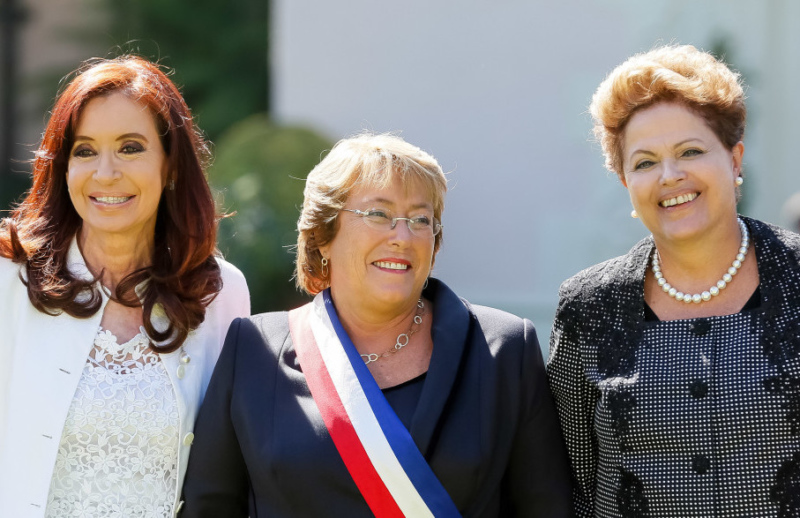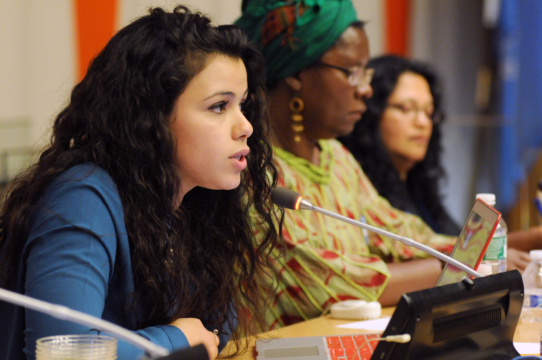What Roles are Women Playing in Mexico’s Drug War?
What roles are women playing in Mexico’s brutal drug trafficking war?
After a four year, constitutionally mandated interval, Chile’s Michelle Bachelet was elected president again last month, following a landslide electoral victory. Although Brazilian President Dilma Rousseff’s approval rating continues to slip, she remains the frontrunner in this year’s presidential race, with first round balloting scheduled in October. After claiming a second term as president in 2011 with a record breaking margin, Argentina’s Cristina Fernandez has seen her support drop precipitously. Mid-term election losses last year closed off any possibility of amending the constitution to allow her to run for a third time in 2015. None of the three presidents will have an easy path in the coming period.
Challenges in Chile
Bachelet returns to the presidency with a number of critical advantages. She piled up a huge electoral majority, leaving the opposition in disarray. The Chilean economy remains robust, though slower growth is likely, and the country’s politics appear stable despite some severe tensions. Some analysts, however, fear that Bachelet has promised too much, and that her government will fall far short of the expectations she has created. Uruguayan President Jose Mujica, advised Chileans to protect what they already had, keeping their aspirations within realistic bounds.
Virtually every Chilean wants economic growth and prosperity, but an expanding middle class also demands that the government step up efforts to address the country’s huge income inequalities, environmental and energy inadequacies, an education system that is way too costly and deficient in quality, and confining political arrangements inherited from the Pinochet dictatorship. These are polarising issues, which, if mismanaged, could readily provoke more angry street marches and protests, particularly among already mobilised student groups.
Foreign policy, albeit a less contentious area, presents its own challenges. Bachelet pledged to make Latin America her top priority, particularly to rebuild ties with Brazil and other nations neglected in the past four years. But relations with the US and other critical economic partners also need attention. She will confront deep nationalist sensitivities in dealing with troublesome boundary disputes with Bolivia and Peru. Two natural disasters during Bachelet’s first month in office – a devastating earthquake in the north and a catastrophic fire on the outskirts of Valparaiso – have complicated her agenda and will require enormous investments to repair the damages. Second term, moreover, is often replete with unanticipated pitfalls.
Still, Bachelet is a skilled politician and communicator. This time around, she comes with the advantage of experience and greatly enhanced personal authority, while the opposition has been weakened. Bachelet governed effectively in her first term and was exceptionally popular when she left office, but her legacy will mostly be determined by the accomplishments and setbacks of her second and final term.
Dilma’s Drive for Re-election
The hand-picked successor of Luiz Inacio Lula da Silva, Brazil’s most popular politician ever, Dilma Rousseff, won her election relatively easily. She assumed office in 2011, virtually at the peak of Brazil’s meteoric rise – a period of some eight years when Brazil grew faster than it had for more than a generation; poverty and inequality declined notably; an expanding middleclass, although still vulnerable, came to outnumber the country’s poor, and Brazil’s regional and global influence soared. During her first year, however, inflationary pressures began to build and the economy slowed precipitously as international demand for Brazilian commodity exports fell. For more than two years, Dilma (like athletes, politicians in Brazil mostly go by first names only) remained popular, carried along by a combination of sheer momentum, low unemployment, Lula’s consistent support, and her low tolerance for corruption.
By mid-2013, however, massive protests – first triggered by a modest rise in bus fares – erupted in cities across the country. More than one million people took to the streets demanding reform of Brazil’s notoriously inadequate public services, narrowing the nation’s vast income disparities, and a halt to lavish, often corrupt government spending. Brazilians cheered Lula when their country was designated to host the world’s two greatest sporting events – World Cup Soccer and the Olympic Games. The same crowds have since denounced Dilma’s government for wasting public money on stadiums while neglecting public transport, schools and health facilities. Dilma’s support sunk rapidly from high of over 60 percent to around 30 percent. Yet, she still leads all other candidates, and with Lula providing a strong tailwind, the odds are she will be re-elected in October. Interestingly, the only potentially competitive rival is another woman, Marina Silva, now slated to run for vice president on an opposition party ticket.
Many things could derail Dilma’s drive for a second term – for example, a surge in inflation or unemployment, an extended energy shortage, mishandling of street protests, replays of recent political scandals, and security breaches or other major breakdowns at the World Cup (some might include here a poor performance of the Brazilian team). If she is not re-elected, Dilma will leave office without making much of an impact. She could certainly remedy that in a second term by addressing some of Brazil’s long-term structural deficits, which have become obvious to even the casual observer – a badly functioning judicial system; deteriorated infrastructure; wasteful and regressive taxes and regulations; mediocre schools and universities; and myriad barriers to trade, investment, and innovation. But even Brazil’s most successful presidents have not been able to make much headway on these fronts.
Argentina after Fernandez
Argentine President Cristina Fernandez won her first term in 2007, when her husband and predecessor Nestor Kirchner, asked her to run in his place. She was subsequently re-elected by a surprisingly large margin in 2011, following her husband’s death. Credited with engineering Argentina’s rapid recovery from its deep economic and political crisis of 2001/2002, Fernandez and Kirchner were extraordinarily popular presidents, at least until recently. For many years, Argentina’s growth rate was among the highest in Latin America, benefitting from one of the largest debt defaults ever and the huge rise in world commodity prices.
Shortly after Fernandez’s re-election in 2011, the economy began to sag. Inflation (though consistently underreported at home) accelerated until it was among the highest in the world, foreign investors looked elsewhere, subsidies for consumers and businesses drained national budgets, and reserves steadily declined. As the situation continued to deteriorate, often made worse by questionable government policies, Fernandez’s political support dwindled. The poor performance of her political allies in last year’s mid-term elections left her more and more as a lame duck president.
By late 2013, the growing risk of economic crises, already predicted by many mainstream economists and financial institutions, prompted the Fernandez government to moderate its course and adopt a series of orthodox measures to stabilise the economy and stem the loss of reserves. Although unlikely to produce a sustained recovery, these changes should be enough to postpone a serious crisis. It will be the task of the next government to make the deeper, more painful adjustments needed to revive the economy. While Fernandez will leave office with a tarnished record, many believe she may well retain an important proportion of political influence and popular support.
Gender and Governance
It is too early to speculate about the legacy of South America’s first three elected women presidents, let alone draw conclusions about whether their gender has made a difference in their governance. Only one of the three, Fernandez, is nearing completion of her presidency. Bachelet has almost full four years to go, while Dilma is also likely to win a second, four-year term. All of them were closely identified with historically popular and successful predecessors.
Fernandez succeeded her husband, whose aggressive, unconventional policies coupled with sky-high soybean prices brought the Argentine economy out of deep depression. Many believed he remained in charge even after the election of Fernandez, who introduced few policy changes. Indeed, the current economic reversals might have been avoided if Fernandez had not stuck so stubbornly to an increasingly destructive set of policies.
Dilma served as her predecessor’s chief of staff for his last five years in office. Nearly all of her key cabinet appointments were also top-level officials in the Lula administration. Her policies hardly wavered from his, and he has played a central political role in her government, with congressional leaders, governors, and party chieftains. The difference between them was in style not substance, but few political leaders have ever managed to convey Lula’s warmth and ebullience. In a second term, Dilma might still leave a powerful mark if she is able to intensify her anti-corruption efforts and begin the long needed overhaul of Brazil’s unproductive economic culture and policies.
Bachelet is probably best situated to create her own legacy. Although she served as a minister throughout the government of Ricardo Lagos, she has managed to maintain an independent identity. Lagos was not, in contrast to the predecessors of Fernandez and Dilma, an active presence during her first term. Now a successful second term at a time that Chileans are crying out for change but uncertain about where they want to head, could establish Bachelet as one of Chile’s most important leaders ever. But whether she succeeds or fails, her performance, even along with those of Dilma and Fernandez, is unlikely to provide much of an answer to the question of whether women rule differently than men.
What roles are women playing in Mexico’s brutal drug trafficking war?
How are women faring in Latin America? Where has progress been made and how has that been achieved?
How do Latin America’s total abortion bans affect women’s health and human rights?
 Roberto Stuckert Filho / PR / CC BY-NC-SA 2.0
Roberto Stuckert Filho / PR / CC BY-NC-SA 2.0

